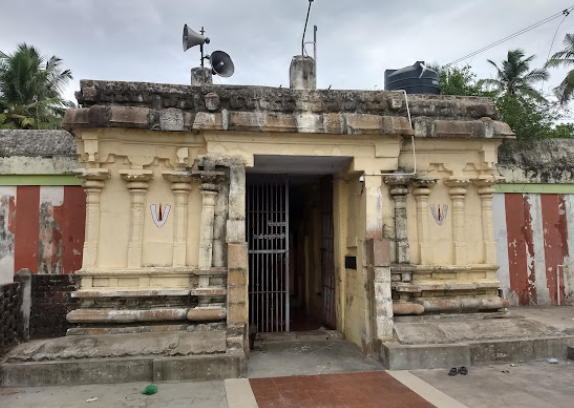The Varadharaja Perumal Thirukovil in Valaingman, Thiruvarur, is believed to have ancient origins, with its establishment dating back to the Chola period, renowned for temple construction and patronage of the arts. The temple has undergone various renovations and restorations over the centuries, maintaining its historical and architectural significance. Legends suggest that the temple was built to honour Lord Varadharaja Perumal, a manifestation of Lord Vishnu, who is revered as the bestower of boons. The temple's intricate carvings and inscriptions reflect the artistic prowess of the era. It has served as a spiritual centre for devotees, hosting various religious ceremonies and festivals. The temple continues to be a significant pilgrimage site, drawing visitors from across the region.

Shri Valangaiman Perumal Temple
The Varadharaja Perumal Thirukovil is located in Valangaiman, a village in the Thiruvarur district of Tamil Nadu. This temple, dedicated to Lord Vishnu, features traditional Dravidian architecture with intricate carvings and a prominent gopuram (tower). It is a serene and sacred site, frequented by devotees seeking the blessings of Varadharaja Perumal. The temple is especially vibrant during festivals, showcasing local traditions and cultural practices.
Timings
Morning: 6:00 AM to 12:00 PM & Evening: 4:00 PM to 8:00 PM
Entry Fee
No entry fee is charged
Do's and Don'ts
- Dress Respectfully: Wear traditional Indian attire or modest clothing that covers your shoulders and knees.
- Maintain Silence: Observe a quiet demeanour to contribute to a peaceful atmosphere within the temple.
- Remove Footwear: Take off your shoes before entering the temple to maintain cleanliness.
- Offer Prayers Sincerely: Engage in heartfelt prayers and worship with genuine devotion.
- Respect Rituals: Observe and follow the temple’s rituals and customs with reverence.
- Make Donations (Optional): Consider making a donation in the designated hundi or collection box to support the temple’s upkeep.
- Carry Essentials: Bring necessary items like water and small change for offerings.
- Follow Temple Guidelines: Adhere to any specific rules or guidelines set by the temple authorities.
- Ask for Permission: Seek permission before entering restricted areas or taking photographs if allowed.
- Be Mindful of Others: Ensure your actions do not disturb other visitors or interfere with ongoing rituals.
- Dispose of Waste Properly: Use designated bins to keep the temple premises clean.
- Do Not Wear Leather Items: Avoid wearing leather belts, shoes, or bags inside the temple.
- Avoid Loud Conversations: Refrain from engaging in loud conversations within the temple premises to maintain a serene environment.
- Do Not Touch Idols: Refrain from touching temple idols or sacred objects, as it is considered disrespectful.
- Do Not Take Photographs in Restricted Areas: Respect areas where photography is prohibited and follow the temple's rules about photography.
- Do Not Litter: Keep the temple premises clean by disposing of waste properly.
- Avoid Consuming Non-Vegetarian Food: Adhere to the temple’s vegetarian practices by not bringing or consuming non-vegetarian food.
- Do Not Enter the Sanctum Sanctorum if Menstruating: Respect this common practice by avoiding entry into the inner sanctum during menstruation.
- Avoid Wearing Headgear: Remove hats, helmets, or any head coverings before entering the temple.
- Do Not Disturb the Rituals: Avoid interrupting or interfering with ongoing rituals and ceremonies.
- Don’t Leave Personal Belongings Unattended: Keep your personal items with you and avoid leaving them in the temple premises.
- Don’t Engage in Public Displays of Affection: Maintain decorum by avoiding public displays of affection within the temple.
- Avoid Smoking or Chewing Tobacco: Refrain from smoking or using tobacco products on temple grounds.
Dress Code
For Men: Wear traditional Indian attire such as dhoti and kurta, or modest clothing that covers the shoulders and legs.
For Women: Opt for traditional Indian attire like sarees or salwar kameez, or modest clothing that covers the shoulders and knees.
How to reach
By Road:
From Thiruvarur: The temple is about 39 km from Thiruvarur. You can hire a taxi or use local buses that connect Thiruvarur to Valangaiman.
From Chennai: The temple is approximately 300 km from Chennai. You can drive or take a bus to Thiruvarur and then continue to Valangaiman by local transport.
By Train: Thiruvarur Railway Station, which is well-connected to major cities in Tamil Nadu. From Thiruvarur, you can take a taxi or bus to Valangaiman.
By Air: Tiruchirappalli International Airport, approximately 105 km from Thiruvarur. From the airport, you can hire a taxi or take a bus to Thiruvarur and then proceed to Valangaiman.
Nearby Cities and Rivers
Rivers:
- Vennar River: A tributary of the Kaveri River, the Vennar River flows through the Thiruvarur district and is important for local agriculture.
- Koraiyar River: Another minor river in the Thiruvarur district, it is a tributary that contributes to the local irrigation system.
Nearby Cities:
- Thiruvarur: The city where the Varadharaja Perumal Thirukovil is located, Thiruvarur is a historic city known for its temples and cultural heritage. It is well-connected to other parts of Tamil Nadu.
- Thanjavur : Approximately 55 kilometres west of Thiruvarur, Thanjavur is known for its historic temples, including the Brihadeeswarar Temple, and its rich cultural and artistic heritage.
- Kumbakonam: Located about 30 kilometres north of Thiruvarur, Kumbakonam is famous for its numerous temples and is a significant cultural and religious centre in TamilNadu.
- Chidambaram: About 80 kilometres southeast of Thiruvarur, Chidambaram is renowned for the Nataraja Temple and its vibrant cultural history.
- Cuddalore: Situated around 100 kilometres east of Thiruvarur, Cuddalore is a coastal city known for its port and historical sites.